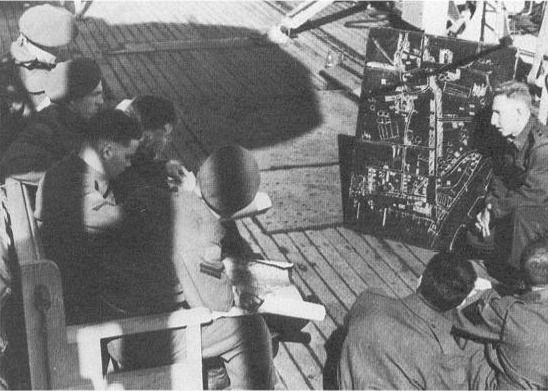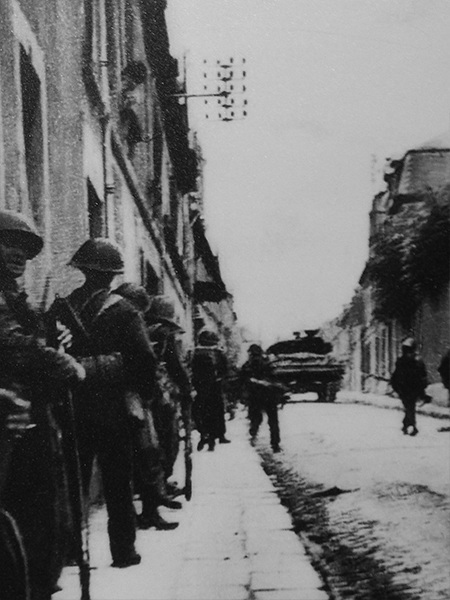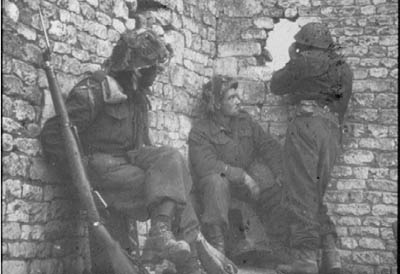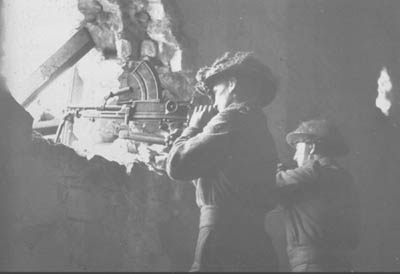

The Regina Rifles landed on the Nan Green sector at Courseulles, east of the river. With one 75mm gun, one 88mm, three 50mm anti-tank guns, twelve machine gun pillboxes and two 50mm mortars plus an additional two 75mm guns on the flanks, Courseulles-sur-Mer was the most heavily fortified position of the Anglo-Canadian beaches. 'A' Company landed at 8:05, followed by 'B' Company at 8:15, 'C' Company at 8:35 and 'D' Company at 8:55.
Upon landing 'A' Company was under immediate attack by the German artillery and machine guns. The preliminary bombardment had failed to knock out many German defensive positions and the near invulnerable pill-boxes could be destroyed only by direct hits through their observation slits. Fortunately fourteen DD tanks of the 1st Hussars made it ashore ahead of the infantry and engaged the guns. Working in tandem, the tanks and infantry succeeded in fighting their way off the beach. The DD tanks knocked out the 88mm, 75mm and 50mm guns with direct hits, but not before the 75mm had fired 200 rounds at the Canadians. In a left flanking movement the Reginas succeeded in breaking through the defences.

Lieutenent RR Smith Briefs his NCO's

Troops from the Regina Rifles follow a DD tank through the streets of Courseulles at about 9:00 on June 6th, 1944.
They will shortly be engaged in battle with a German strongpoint located several hundred yards ahead in the fields just behind the town.
Stewart Mein from a history of the Reginas titled Up the Johns: "The men of 'A' Company lay huddled on the beach, exposed to the withering fire directed at them. They could go no farther. However, Lieutenant Bill Grayson made a mad dash for the emplacement. The rear man, on seeing Grayson, threw a 'potato masher' grenade at him, which landed between his legs. Cooly, Grayson reached down and threw the grenade back at the German. Grayson then followed the Germans into a trench which zigzagged to an underground area. Out came 35 men whom he promptly took prisoner. With the 88mm gun out of action, 'A' Company was able to push on into the town. For his daring action, Grayson was later awarded the Military Cross."
Major Gordon Baird described the landing in the book The Regina Rifle Regiment 1939-1945: "So far, not a shot has been fired from the defenders on the beach. Will it be a push-over? We soon have the answer in the form of machine-gun fire and shells from pillboxes which are apparently still open for business despite the terrific pounding they have taken. The LCA's of the leading companies and the tanks of the 1st Hussars are working into the beaches now. H-hour has arrived. For the purposes of the assault, Courseulles had been divided into blocks numbered one to twelve. Each was to be cleared by a designated company. Careful study of enlarged air photos showing the sites of enemy strong points had made the ground itself easily recognizable. Every foot of the town was known before it was entered."
'B' Company landed on the left and engaged the pillboxes positioned along the promenade. With good support from the DD tanks they got off the beach quickly and began clearing the town of Courseulles-sur-Mer. AVRE's opened up beach exits and the tanks moved into town to provide help to the infantry. In house-to-house combat, 'B' Company cleared blocks 2, 3, 4 and 12. 'A' company cleared blocks 5, 6, and 7 but had to return to block 1 where the Germans had returned by tunnels and trenches to reoccupy their guns. The Reginas began the disheartening task of clearing the gun position again.

A forward observation post of the Regina Rifle regiment, Bretteville-l'Orgueilleuese, June 8-10.
When the reserve companies came ashore, 'C' company, led by Major Stu Tubb, touched down without mishap, moved quickly into Courseulles and proceeded to clear blocks 8 through 11. 'D' company, commanded by Major Jack Love, lost two craft by mines. Heavy casualties resulted including the company commander who was killed. The remainder of 'D' company, reduced to forty-nine men, re-organized and set out as planned to Reviers, two miles inland, to seize the bridges over the Mue River. They arrived there at 11:00.
Major Baird: "Supporting arms had done a wonderful job. Baker squadron, 6th Canadian Armoured Regiment (First Hussars), had given invaluable aid. Guns of the 13th Field Regiment had proved excellent support in the initial phases of the landing. With us too were elements of the Cameron Highlanders of Ottawa (the support battalion), reconnaissance groups from the 17th Duke of York's Royal Canadian Hussars, and 3rd Anti-tank Regiment."

Regina Rifle soldiers manning a Bren gun.
As the companies overcame resistance in their areas, they pushed inland to the village of Reviers. 'C' Company moved up to Reviers and Battalion Headquarter was established there at 1500 hours. 'B' and 'A' companies arrived next. The battalion rested there and awaited orders to move on. The Reginas began to advance southward from Reviers at about 1700 hours and by 2000 hours both Fontaine-Henry and Le Fresne-Camilly were in their hands. Major Baird described the advance: "It was night: the John's were digging in the fields of Normandy - on D-Day and in enemy-held territory. We were on our own now. But the plan of the High Command had been carried out - to assault and break through, exploiting rapidly inland. This meant taking the chance of being cut off. And we were on our intermediate objective as ordered."
The Regina's had secured their D-Day objective in a day of hard bitter
fighting, and controlled all of Courseulles and its small but significant
port at the mouth of the Seulles River.
